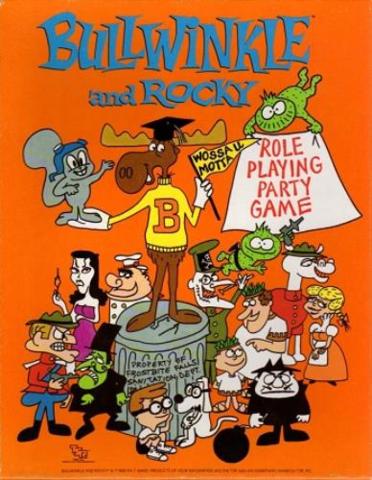I started to feel that I didn’t know roleplaying games well enough so I came up with the plan to read a roleplaying game corebook for every year they have been published. Selection criteria is whatever I find interesting.

Originally, I planned to read something else entirely for 1988, but friends wiser than me suggested I take a look at the Bullwinkle and Rocky Role-Playing Party Game. And they were right! This is an extremely interesting example of roleplaying game design, especially for its time.
American pop culture is not distributed to the rest of the world evenly. Some American cartoons were broadcast in Finland, while others were not. We got Looney Tunes and DuckTales but I don’t remember ever seeing The Adventures of Rocky and Bullwinkle and Friends on Finnish tv. I had to google it when I started reading the roleplaying game.
So, this is a licensed roleplaying game based on a cartoon, published by TSR (the company behind D&D), designed by David Cook and Warren Spector. This is already the second game from Spector I’ve read, the first being Toon (1984).
The contents of the game box itself are quite attractive. Instead of dice the game has spinners unique to each character. Thus, Bullwinkle loses much more often than Rocky. There are diplomas that you can give to players, a stack of cardboard character stands so you know who’s playing who and a deck of cards you can use for randomizing story beats.
Best of all, there are plastic hand puppets of all the major characters. They bring a pleasant air of playfulness to the proceedings.

Bullwinkle and Rocky is a light, chaotic game which embraces the spirit of communal storytelling. It’s more about coming up with fun cartoon antics than serious engagement with game mechanics. It has a lot of the same DNA as Toon, but it benefits greatly from a specific milieu and characters, as well as the modern design.
Among the features that predate modern storygames, Bullwinkle and Rocky has a rotating Game Master role, where each player takes on the task of the Narrator in turn. It has several game modes, the simplest of which is pure communal storytelling. The more complex ones introduce characters.
There’s even something for the Nordic Larp audience to like, with a strong focus on play to lose. After all, most of the characters are incompetent fools, so it stands to reason everything they try fails. The key is to make it fail in an entertaining way.
Retrospectively, Bullwinkle and Rocky feels like a harbinger of things to come. Its lean design throws revolutionary ideas around so casually, it demands a status as an early classic.